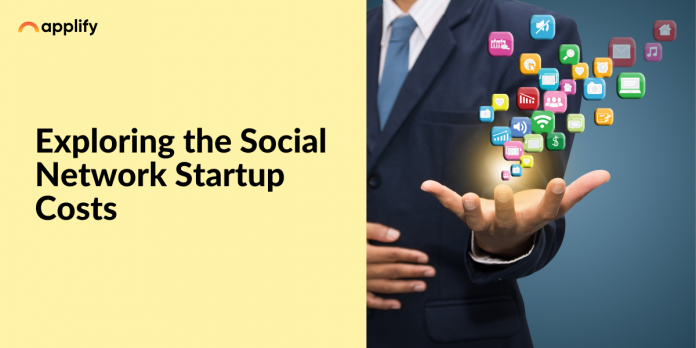Social network startup costs can be expensive but being a top category, it’s worth every penny of your investment. The cost of developing a social media app depends on factors like features, complexity, platform, and development team expertise.
While developing a social media app can incur varying costs, it is generally regarded as a substantial investment. In this blog, we will explore factors affecting social media app development costs and provide cost-saving tips without compromising quality.
The Popularity of Social Media Apps
Social media apps have become an integral part of our daily lives, providing a platform for communication, networking, and entertainment. Moreover, with the widespread availability of smartphones and affordable Internet, social media apps have gained immense popularity across the globe. Facebook, Instagram, and Twitter are popular social media apps that have revolutionized communication and information sharing.
Exploring the Social Network Startup Costs
Predicting the exact cost of developing a social networking app is challenging, but we can provide general cost estimates.
The cost of developing a social media app can vary depending on the scope and complexity of the project. However, on average, developing a good social networking app is somewhere between $100,000 to $150,000 or more. The cost can be significantly higher if the app includes advanced features or is being developed for multiple platforms.
- A basic social network app can cost between $30,000 to $80,000 and take around 3 to 6 months to develop.
- Medium-level social network apps can cost between $80,000 to $150,000 and take around 6 to 9 months to develop.
- High-level social network apps can cost between $150,000 and more and take over 9 months to develop.
Related: What is the Cost of Developing an App in Singapore?
The Features Required in a Social Media App

1. Basic Features Required
The basic features of a social media app include user registration, authentication, newsfeed/timeline, social sharing, and user profile management. These features are essential for any social media app and are usually the starting point for app development.
2. Advanced Features that can Enhance the App’s Performance
Advanced features can enhance the user experience and increase the app’s performance. Some of the advanced features commonly found in social media apps include real-time messaging and chat functionality, push notifications, advanced search and discovery options, video and live streaming capabilities, photo, and video editing tools, and augmented reality features. The inclusion of these features can help set the app apart from the competition and attract a larger user base.
3. Discussion of the Additional Costs of Advanced Features
Incorporating advanced features into a social media app can significantly increase the cost of development. These features require more complex programming and may require the integration of third-party services or APIs.
Additionally, advanced features may require additional server resources and infrastructure to handle the increased traffic and data storage needs. Careful consideration of the cost and benefits of each advanced feature is crucial before including it in the app. Working with an experienced development team is essential for guidance on integrating these features effectively and cost-efficiently.
Related: What is the Average Cost to Develop an iPhone App?
Development Cost of a Social Media App
The social network startup costs can be broken down into several elements, including the cost of design and development, hosting and infrastructure costs, and ongoing maintenance and support costs.
Design and development costs include expenses related to creating wireframes, designing the user interface, and developing the app’s functionality.
Hosting and infrastructure costs involve the expenses associated with the cloud hosting service, server maintenance, and database management.
Ongoing maintenance and support costs include bug fixes, software updates, and customer support.
Explanation of Factors That Affect the Cost of Developing a Social Media App
Several factors can impact social network startup costs, including the complexity and scope of the project, the features and functionality of the app, the platform for which it is being developed, and the development team’s experience and location.
The cost can also be affected by the need for integrating third-party APIs or services, the use of advanced technologies like AI or AR, and the design and branding requirements of the app. Additionally, factors like the cost of hiring developers, project management, and the length of the development cycle can also impact the overall cost of the project.
Understanding these factors and carefully planning the development process can help manage the cost and ensure a successful outcome for the project.
Related: Web Development Cost Breakdown: Where Does Your Money Go?
How Can You Save Social Network Startup Costs?
Developing a social media app can be a costly process, but several measures can be employed to cut down on expenses. One of the most effective ways to reduce costs is by carefully planning the project and identifying the essential features needed for the app’s success.
Prioritizing core features and functionalities and implementing them first can help reduce development time and costs.
Additionally, using open-source frameworks and libraries, leveraging pre-built components, and outsourcing non-critical tasks can help cut down on development costs without compromising the app’s quality.
Saving Measures for Social Network Startup Costs
There are several measures to save social network startup costs that can be employed during the development of a social media app without compromising quality, including:
1. Agile Development Approach
Adopting an agile development approach can help reduce development time and costs. The iterative nature of the agile methodology ensures that the development team focuses on building the app’s core features first, allowing for testing and feedback before proceeding with additional features.
2. Use of Pre-Built Components
Implementing pre-built components can save development time and cost. Moreover, by integrating open-source libraries, developers can leverage pre-built components like chat functionality or login systems, eliminating the need to build these features from scratch.
3. Outsourcing Non-Critical Tasks
Outsourcing non-critical tasks, like UI/UX design or QA testing, can help reduce development costs without affecting the app’s quality. A skilled third-party vendor can be more cost-effective than hiring an in-house team.
4. Cloud Hosting Services
Cloud hosting services like Amazon Web Services or Microsoft Azure offer cost-effective solutions for hosting and scaling a social media app. Additionally, these services provide scalable and reliable infrastructure, eliminating the need to invest in expensive hardware.
5. MVP Approach
Adopting an MVP (Minimum Viable Product) approach can help save development costs by focusing on the app’s essential features first. An MVP approach involves developing the core features of the app first and then iterating based on feedback from users, reducing development costs and ensuring the app’s success.
Related: What Should be the First Version of Your App: MVP vs Prototype?
App Monetization Strategies for Social Network Apps
Social media apps have become an integral part of our lives, and many entrepreneurs are now looking to monetize their social media apps. Additionally, there are different ways to monetize social media apps, with some of the most popular strategies including advertising, subscription-based models, and in-app purchases.
- Advertising: This is the most common way social media apps generate revenue. App owners can generate revenue by charging advertisers to display their ads on the app, with the revenue being based on the number of clicks, impressions, or conversions.
- Subscription-based models: This monetization strategy requires users to pay a fee to access premium features or content.
- In-app purchases: This strategy allows users to make purchases within the app, such as buying virtual goods, unlocking additional features, or upgrading to a premium version.
- Freemium model: This model offers basic features for free, while users have to pay to access premium features. This strategy allows app owners to build a user base and generate revenue from premium features.
Related: How to Write a Business Plan for a Mobile App Startup?
Final Thoughts
Although social network startup costs can be quite high, they can also be highly lucrative if done correctly. It’s essential to understand the costs involved and take steps to mitigate those costs, such as employing cost-saving measures and selecting the most appropriate monetization strategy.
However, the benefits of developing a social media app can outweigh the costs, as it provides an opportunity to create a large user base and generate significant revenue.
Social media apps have the potential to become global phenomena and can lead to great success for their developers. So, entrepreneurs should not be afraid to take the plunge and explore the possibilities of developing a social media app.









